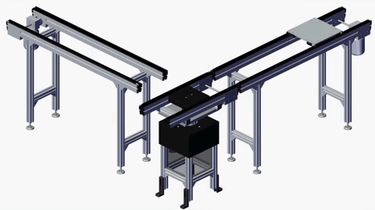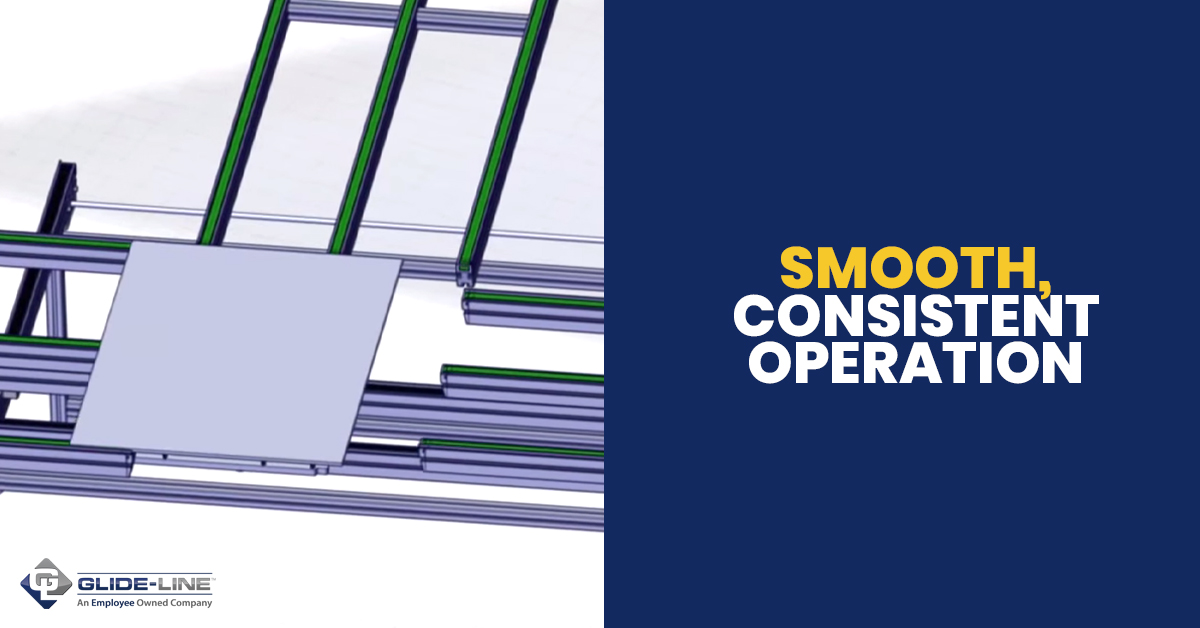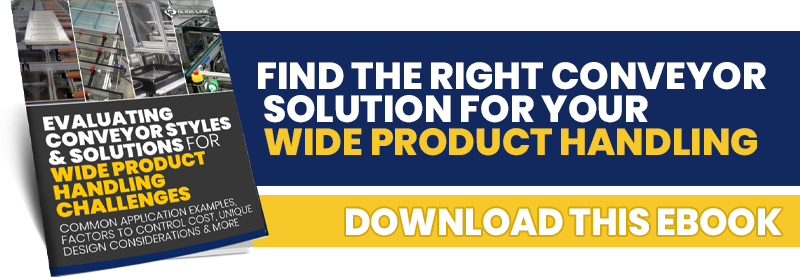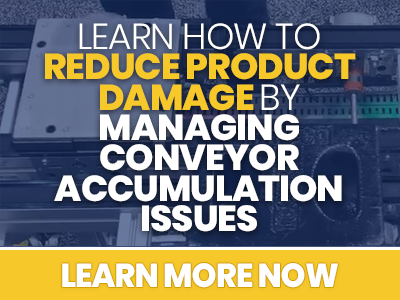Glide-Line offers two types of lift and rotate devices.
The standard LRU is a device mounted along the length of a fixed conveyor and is designed to lift a pallet high enough to clear the conveyor guide rails, rotate it and lower it back onto the conveying surface.
DART is a floor mounted lift and rotate device that supports a short section of conveyor. Once the pallet or product transfers onto this short section the entire section will lift to clear the adjacent conveyors, rotate and lower back into its new position.
In either case, the lift motion is pneumatic, and the rotating motion is step-servo driven.
The advantage of a step-servo-driven rotating system is that it offers programmable position, speed, direction, acceleration and deceleration, giving the operator complete control over the motion profile for smooth consistent operation.
Programmable Step-servo-powered Rotation
Often, electrically driven servo motors are thought to be more complicated to set up and operate than pneumatic actuators. However, that’s not the case with Glide-Line’s LRU and DART conveyor devices.
No programming experience or software is required to effectively operate the device. Although the step-servo lift and rotate unit motor is fully programmable, it’s pre-programmed and configured to operate like a pneumatic rotary actuator. We provide a simple interface that allows the user to control move angle, direction, speed, acceleration and deceleration using discrete input signals, the same way you would operate a series of pneumatic valves. The step-servo also provides feedback signals that it completed its move and report fault conditions.
Pneumatic actuators allow movement between two fixed positions only and it’s often difficult to make it operate in a smooth fashion. A step-servo motor provides a smooth move profile and gives the user programmatic control over speed, direction, acceleration and deceleration, plus it can be programmed to stop at any desired position.
Limited Product Disruption
Pneumatic rotational motion is very difficult to tune even when implementing manually adjustable flow controls and pneumatic cushions. A pneumatic system can only be set up to address one speed/load scenario and the motion is typically jerky and aggressive, especially when trying to move quickly. This aggressive semi-controlled motion can have the unfortunate effect of dislodging or damaging products on the pallet. This isn’t the case with an electric servo motor.
With the step-servo, you have far more flexibility by having programmatic control over all aspects of each rotational move. Many different move profiles and load scenarios can be addressed and speed no longer needs to be sacrificed in order to achieve safe, smooth, and precise operation.
We’ve introduced a new way to maneuver conveyor sections to address difficult traffic control conditions in a way that saves space and increases throughput in system layouts. We’ve found the best way to accomplish this consistently is by utilizing a servo. There are four main pallet rotational motions possible on a basic conveyor application to address these difficult traffic control scenarios. Check out the video below for information on how a servo-driven lift and rotate unit can move product in different ways.
1. Change Product Orientation with a Lift & Rotate Unit (LRU)
A Lift & Rotate Unit (LRU) lifts a pallet off the main line, rotates to 90 degrees or 180 degrees, then drops down to the main line again. The purpose of the LRU is to change the product’s orientation without making physical contact with the product. This minimizes the risk of jarring the product or damaging it while changing its direction.
Another variation on the LRU is a floor-mounted Lift & Rotate Unit known as DART. This floor mounted device supports a section of conveyor. This section of conveyor is lifted, rotated and lowered to either turn the product 180 degrees or discharge the product onto another conveyor line similar to a train yard turntable, enabling the DART to be used as a traffic control device.
2. Maintain Product Orientation with a Drop & Rotate Unit (DART)
A servo-powered Drop and Rotate Unit (DART) can be set up to drop and rotate as opposed to lift and rotate. This can be used to manage the pallet flow through a 90 degree turn without changing the pallet orientation. It maintains the orientation by dropping a section of conveyor and letting the pallet rest on a fixed platform while the rotation occurs beneath. The section of conveyor rotates 90 degrees and re-engages the pallet on its way back up. This method is typically used as an alternative to a lift and transfer device when dealing with large heavy pallets. Although it’s ideal for the pallet to be square, a cam style mechanism can be used to change the conveyor width as the unit rotates allowing it to re-engage the longer or shorter side of the pallet.
3. Continuous Product Revolution
 Lift rotate devices can revolve continuously, smoothly, and predictably. The servo-driven Lift and Rotate from Glide-Line is not only used to change the flow direction of a pallet but can be used to control process orientation. This is especially useful for situations where a machine needs easier access to place or read a label, wind a cord around a spool, or provide 360-degree visibility to an inspection camera. Whether moving large or small pallets, continuous revolution can help you configure a more efficient process layout.
Lift rotate devices can revolve continuously, smoothly, and predictably. The servo-driven Lift and Rotate from Glide-Line is not only used to change the flow direction of a pallet but can be used to control process orientation. This is especially useful for situations where a machine needs easier access to place or read a label, wind a cord around a spool, or provide 360-degree visibility to an inspection camera. Whether moving large or small pallets, continuous revolution can help you configure a more efficient process layout.
4. Consistent Rotation
Consistent rotation with the servo-driven Lift and Rotate Unit is more than simple oscillation back and forth with a pneumatic motor. The turning servo-driven LRU conveyor pallet moves within a revolution at any angle in unlimited increments and even varying speeds. Its programmable to accomplish defined, accurate, precision pallet stops within a process.
Read more about the advantages of a servo-driven Lift and Rotate conveyor mechanism for automated assembly processes in our ebook.









Leave a Comment